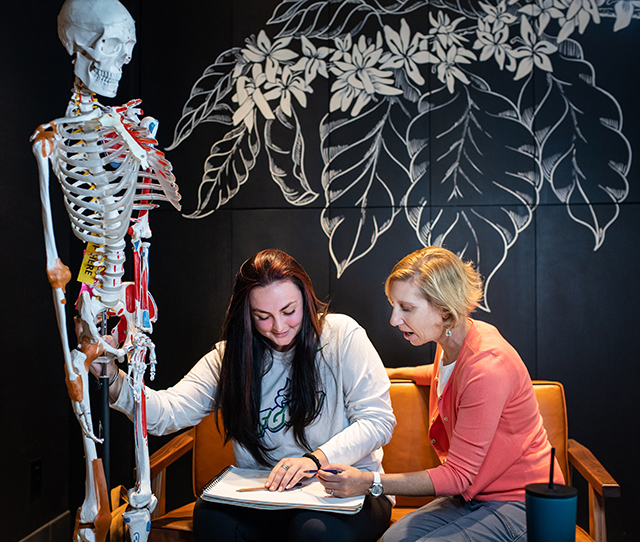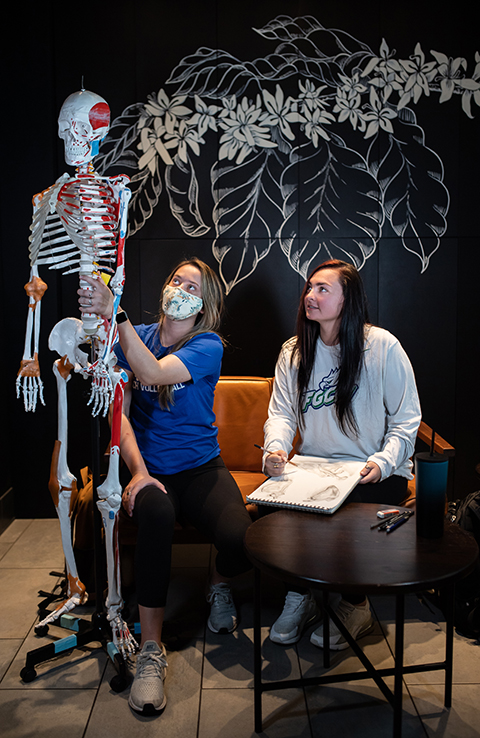Last summer, FGCU senior Kaitlyn Arace caused a stir at her neighborhood Starbucks.
Skeletons don’t appear every day at the local coffee shop, but Arace got used to the stares as she wheeled in a 5-foot-7 skeletal replica borrowed from a friend majoring in forensic science. She’d order an espresso at the counter, choose a table in the corner and arrange the skeleton for optimal lighting. When everything was just right, she’d pull out her sketch pad and get to work, hardly noticing the looks from other customers.

Once in a while, someone would stop by her table. “You must be a medical student,” they’d say. Arace would shake her head, no. “I’m a medical illustrator.”
Arace, 21, is set to graduate in December. She’ll receive her diploma a semester earlier than she initially planned. She intends to use the spring months to build her portfolio so she can apply to graduate programs in medical illustration.
Arace’s drawings are captivating. They’re technically brilliant, down to the light source (in medical illustrations, she says, the preferred angle of light is from the upper left). She captures the fine nuances of organs, tissues, bones and biological processes with an eye for her audience. That audience can range from high school students – think AP Biology textbooks – to physicians. Her drawings are both accurate and compelling.
Given her skillset, it’s easy to imagine that Arace was an artistic child, always doodling in the corner of her notebook. She laughs at the idea. “I was terrible at art,” she says. Instead, Arace loved sports. She played soccer, basketball and softball in high school until a knee injury sidelined her during her sophomore year. She left the playing field and found herself in the art room. That’s where she began drawing the human form as a way to stay connected to her own body. At the beginning, she admits, she wasn’t great. But she stuck with it. “I’m very motivated,” she says. “When I put my mind to something, I’m driven.”
She began by replicating other drawings. In them, she searched for light sources. She measured proportion. She studied color theory. Eventually she noticed how changing a single line could alter an entire picture. Arace calls her time in the high school art room an apprenticeship. There, she worked under the careful tutelage of her art teacher, who first mentioned the idea of a career in medical illustration. “You need to continue doing art,” her teacher said. “You need to stay with this.”

When Arace started classes at Florida Gulf Coast University as a freshman, medical illustration was still fresh on her mind. She enrolled in a basic anatomy course and, flipping through the textbook, she realized that all of the illustrations were done by the same person – Dr. Valerie Weiss, an assistant professor in FGCU’s Marieb College of Health & Human Services. Weiss has both a medical degree and a master of science in medical illustration. She has worked extensively as a medical illustrator. Arace reached out to Weiss, and soon Weiss began serving as Arace’s mentor.
“We just hit it off,” Weiss says. “She was a very mature freshman, and I’ve gotten to see her grow through all these years. She’s so talented, and she’s a hard worker. Now she has her whole life ahead of her. She’s going to do great things.”
At Weiss’s suggestion, Arace switched her major from health sciences to integrated studies. This gave her the freedom to pursue a range of courses, from human physiology to forensics to drawing.
Looking toward the future, Arace knows that medical illustration is a niche career that’s widely in demand. Some illustrators work as freelancers, hiring out their services to textbook designers, advertisers and attorneys (many lawyers prefer to use medical illustrations rather than photographs in court cases because the illustrations are less graphically gruesome). Other medical illustrators prefer to be employees of a larger business. Arthrex, the Naples-based medical device company, has several medical illustrators on staff.
Yet before Arace begins working in her field, she plans to earn a master’s degree in medical illustration. There are just four programs in the country – Augusta University, University of Illinois at Chicago, Johns Hopkins School of Medicine and the Rochester Institute of Technology. Each program has fewer than 25 students at a time. The coursework is a rigorous combination of both anatomy and art. “It’s a hard field of study to get into,” Arace concedes.
But she’s confident she has what it takes. She’s passionate about the field. She’s dedicated years to studying art. And she knows human anatomy and physiology on a deep level. So deep, in fact, that she’s sometimes known to share a cup of coffee with a skeleton.